
By Chuck Meide, Director of the Lighthouse Archaeological Maritime Program - Lighthouse Archaeological Maritime Program
July 14, 2014
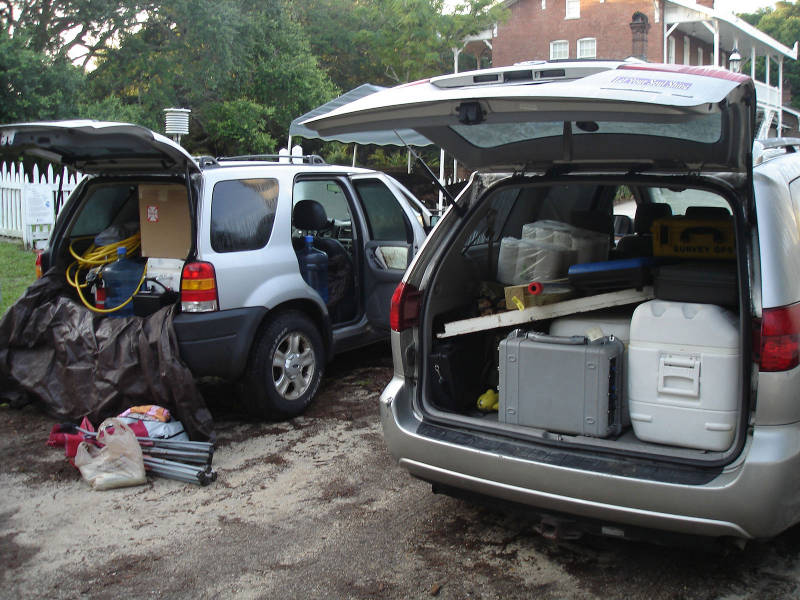
Loading gear at LAMP headquarters. Lots of equipment and food are needed for a seven-day research cruise! Image courtesy of Image courtesy of the Search for the Lost French Fleet of 1565 Expedition, NOAA-OER/St. Augustine Lighthouse & Museum. Download larger version (jpg, 401 KB).
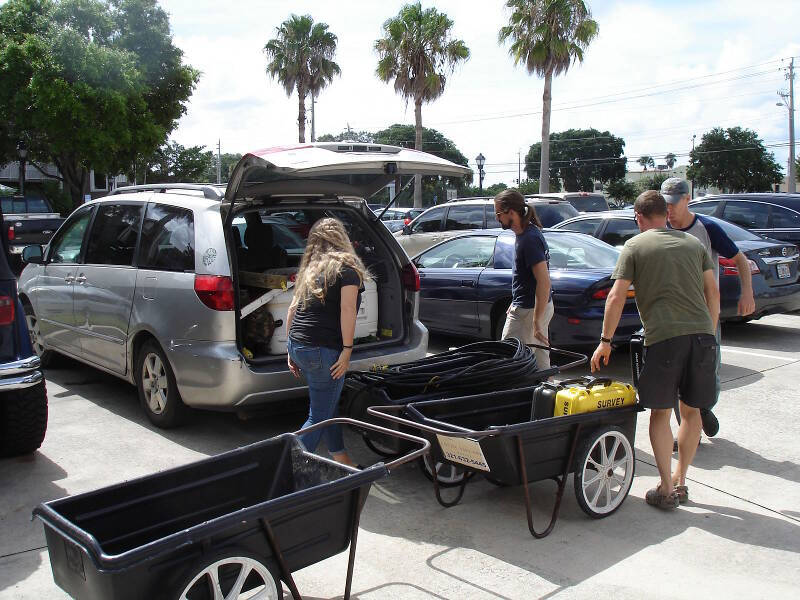
Dock carts are handy for moving lots of supplies from our vehicles to the boat. From left to right, Starr Cox, Brian McNamara, Brendan Burke, and Sam Turner. Image courtesy of Image courtesy of the Search for the Lost French Fleet of 1565 Expedition, NOAA-OER/St. Augustine Lighthouse & Museum. Download larger version (jpg, 437 KB).
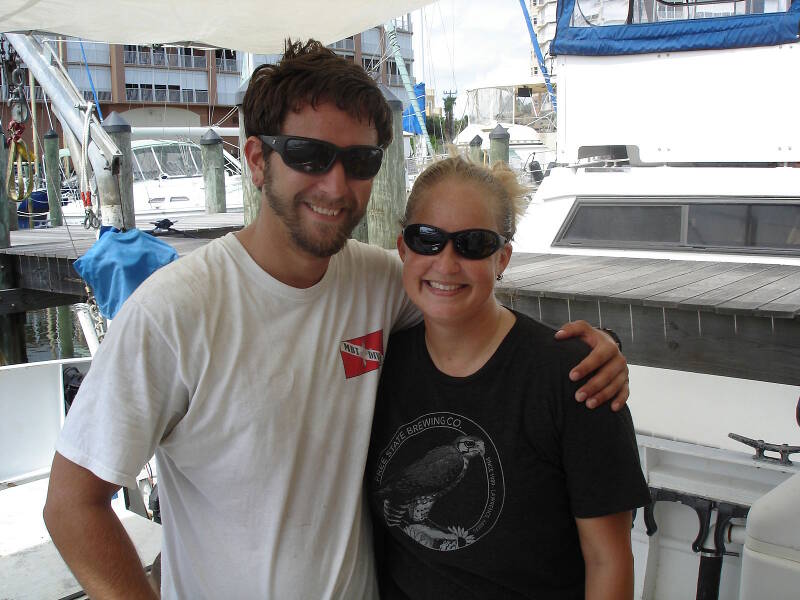
LAMP volunteer Hunter Whitehead and LAMP Archaeological Conservator Starr Cox help with loading and also served as drivers today. They will drive our vehicles back to St. Augustine when the Roper is ready to depart. Image courtesy of Image courtesy of the Search for the Lost French Fleet of 1565 Expedition, NOAA-OER/St. Augustine Lighthouse & Museum. Download larger version (jpg, 328 KB).
Today is Bastille Day, a fitting coincidence for the day we launch our search for the lost French fleet of 1565. The excitement has been building for months, as we have prepared and submitted our permit applications, worked out media plans and research designs, and finalized crew rosters and emergency plans.
All of my team members at the Lighthouse Archaeological Maritime Program (LAMP), along with many of the staff at the St. Augustine Lighthouse & Museum, were working around the clock for the last week especially. We had a press conference last Thursday to announce the start of the search, which was widely attended by members of the communities and media from St. Augustine and Jacksonville. We troubleshot remote sensing equipment, including GPS units, the magnetometer, side scan sonar, and the subbottom profiler, which is relatively new to us. We did a massive grocery shopping spree for food and supplies. We worked with our partners at NOAA to write, film, and edit materials for the project web page.
Two of our crew, Brendan Burke and Brian McNamara, spent the week down in Cocoa, Florida, where they put in countless hours in a marathon of work on the research vessel: installing a newly-rebuilt generator and an entire electrical system (re-wiring outlets, installing breaker panels, installing wiring), installing air conditioning and associated ductwork, replaced the seawater strainer on the engine, changed the engine oil, grinded and painted steel, replaced rusted handrails, disconnected the drive shaft in order to install new engine mounts (unfortunately, the wrong model mounts were shipped, so that repair will wait until later), and replaced the fuel filter bank gauge. When I would next see Roper, she would almost be a totally new boat!
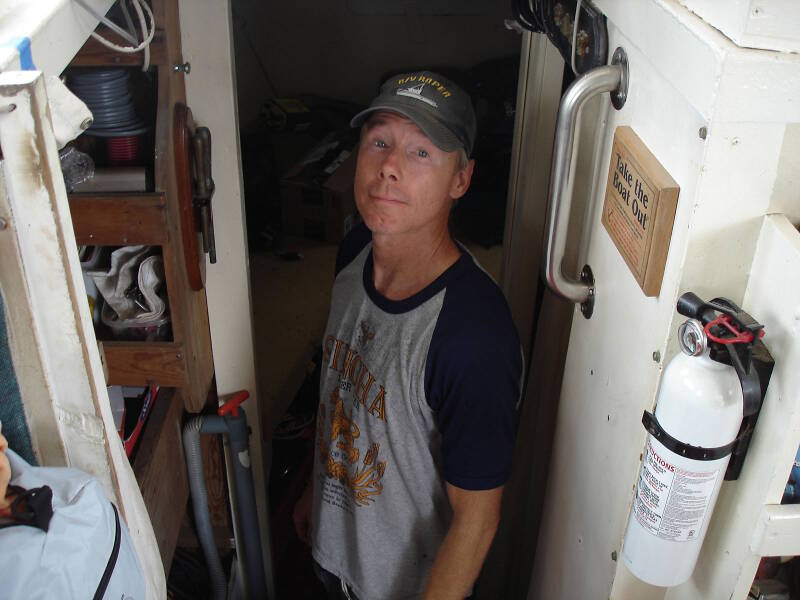
Sam Turner is one of LAMP’s staff archaeologists and is our expert with the marine magnetometer, our primary tool of discovery. He is also a paleographer, able to read 16th-century Spanish script, and has helped with much of the background research related to Pedro Menéndez, Ribault’s rival in the attempt to colonize Florida. Image courtesy of Image courtesy of the Search for the Lost French Fleet of 1565 Expedition, NOAA-OER/St. Augustine Lighthouse & Museum. Download larger version (jpg, 254 KB).
All of this hard work, whether in the bustling office or in the oppressively hot engine room, has lead up to this day. It began for me at 5:00 am as I loaded my car with my personal gear. It is like packing for a week-long camping trip, except I’m bringing along my laptop and some historical reference books.
At 6:00 am, we meet at LAMP headquarters, a World War II-era barracks under the Lighthouse. Assembled are the crew for the first cruise—myself, Brendan Burke, Sam Turner, and Brian McNamara, along with LAMP’s Archaeological Conservator Starr Cox.
Meanwhile, at our Field House (where LAMP students, interns, volunteers, and some staff live), two additional team members are also up early, packing our food, which was stored in the extra freezer and refrigerator there. They are LAMP’s newest staff archaeologist, Olivia McDaniel, and volunteer archaeologist Hunter Whitehead. Hunter is an archaeology student at University of West Florida who worked with us in June as a Supervisor for our annual Field School.
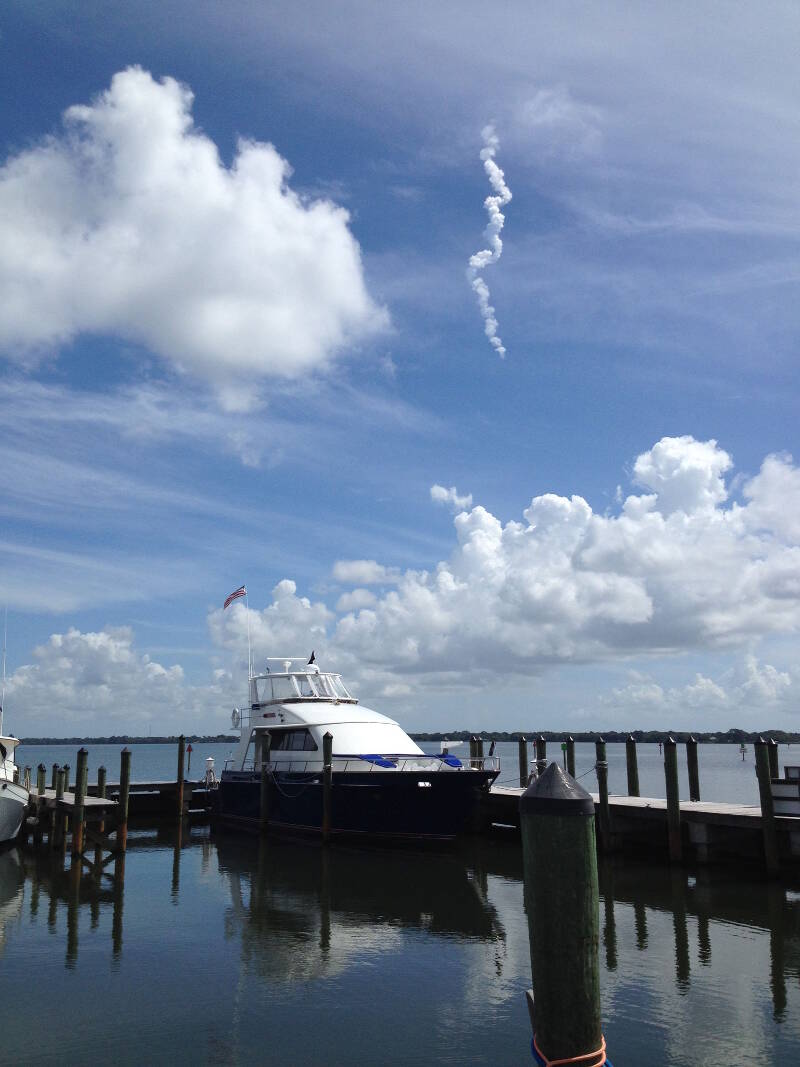
The exhaust trail of a Falcon 9 rocket launched from Kennedy Space Center, visible from Roper at dock. Image courtesy of Image courtesy of the Search for the Lost French Fleet of 1565 Expedition, NOAA-OER/St. Augustine Lighthouse & Museum. Download larger version (jpg, 400 KB).
At LAMP, the task is to begin loading the two vehicles which will transport people and gear to Cocoa, two hours south of St. Augustine. As you can imagine, that is a lot of stuff, especially after Olivia and Hunter arrive with two massive and two regular-sized coolers full of food.
Around 8:00 am, we depart St. Augustine, and we are at Cocoa Village Marina by 10:00. Once there, we begin to unload everything—personal gear, geophysical equipment, food and drinking water, cameras and laptops, and all the other items required for a seven-day research cruise—onto the dock adjacent to our research vessel, Roper.
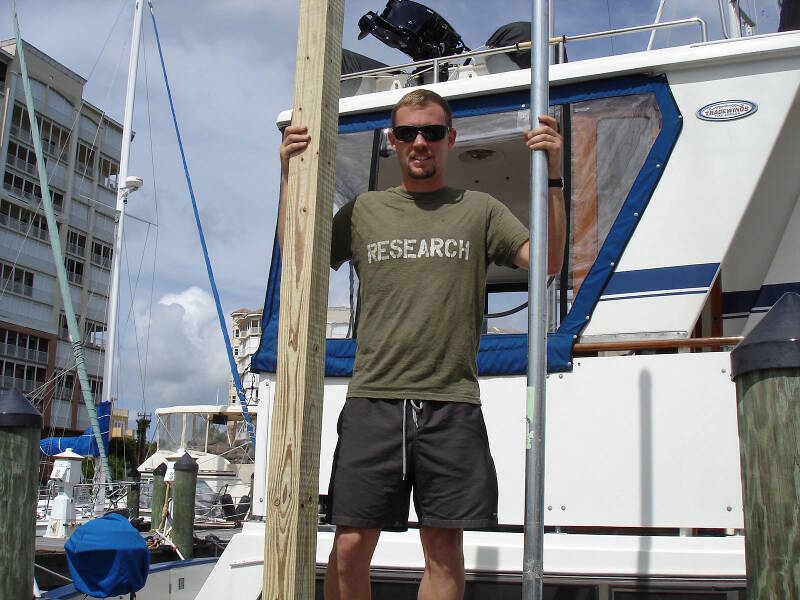
Brendan Burke, LAMP Archaeologist and Logistical Coordinator. Brendan is a licensed boat captain and does a lot of the on-board mechanical work required to keep the boat and equipment going. One of his specialties is the implementation and interpretation of marine sonar. His t-shirt proudly declares our mission! Image courtesy of Image courtesy of the Search for the Lost French Fleet of 1565 Expedition, NOAA-OER/St. Augustine Lighthouse & Museum. Download larger version (jpg, 368 KB).
Once we have unloaded most of the gear, we run a few errands while we wait for a mechanic who is supposed to arrive in order to make one last fix, replacing a leaking fuel injector on the Roper’s engine. Brendan and Starr go to Noah’s Ark Repair, a marine shop run by our friend Mike Potter, to get a backup starter for the generator. Mike has been a great supporter of the project, and has provided a lot of help with the installation of our new generator and air conditioner.
We are taking an extra starter since the currently installed starter has been showing some problems. One of LAMP’s favorite motto’s is “Two is one, one is none.” Once you are offshore, that is a true statement—if we have two starters, then when the first one breaks we will still have one.
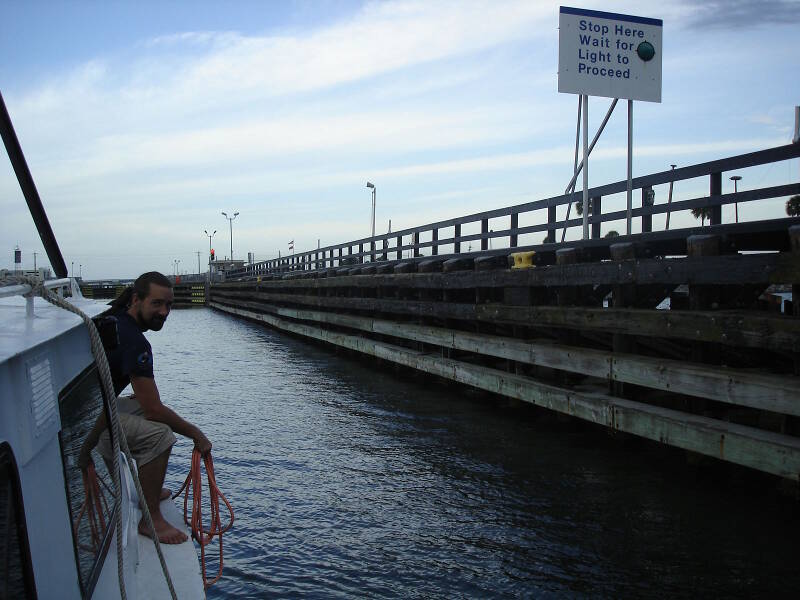
Brian McNamara mans the bow while we enter Canaveral Lock. Brian has been volunteering almost full-time at LAMP since 2011. He is currently finishing his master’s degree in maritime archaeology long distance from Flinders University in Australia. Image courtesy of Image courtesy of the Search for the Lost French Fleet of 1565 Expedition, NOAA-OER/St. Augustine Lighthouse & Museum. Download larger version (jpg, 312 KB).
Meanwhile, Hunter and I have some shopping to do. We’ve realized that we are low on one of our favorite supplies: zip ties and duct tape. We also pick up some last-minute grocery items. At the marina, we get 20 bags of ice to pack coolers.
Back at the boat, Sam is working on stowing all of our gear so that the important stuff is accessible but also secure in case of heavy seas. Brian fixes a fuel line for the new generator.
Once we return from our shopping trip, it is time to load up on ice. It takes a total of 20 bags to fill our one empty cooler to the brim and to pack ice around all of the food in the remaining coolers. We are hoping that the ice will last most of our seven days at sea, though with our new generator, we will have a working refrigerator.
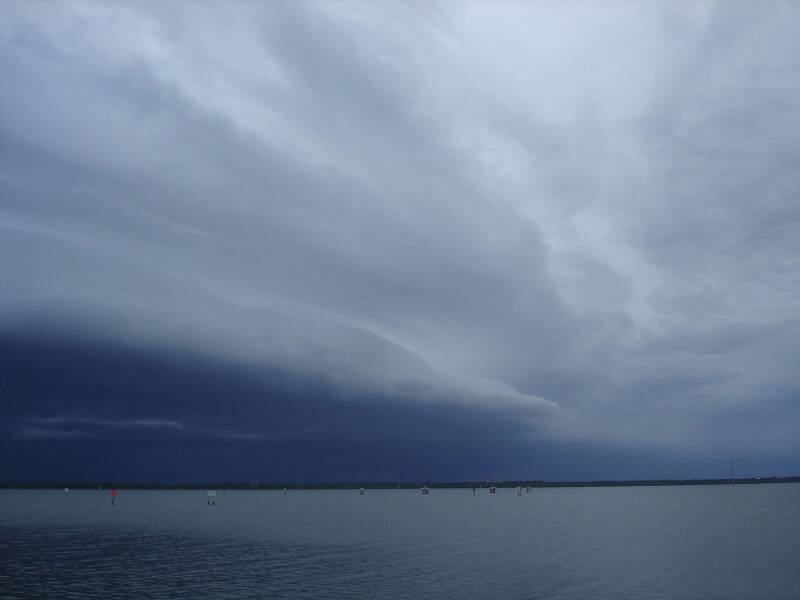
Dark clouds on the horizon mean a storm is coming. The Canaveral area is known as the lightning strike capital of the world, so we need to always be aware of impending weather. Image courtesy of Image courtesy of the Search for the Lost French Fleet of 1565 Expedition, NOAA-OER/St. Augustine Lighthouse & Museum. Download larger version (jpg, 117 KB).
We are not the only explorers to launch an expedition today! With a sudden rumbling we turn our heads to see a rocket launch from nearby Kennedy Space Center! A Falcon 9 rocket was shot into the sky by the private space exploration company, SpaceX.
In the afternoon, we receive word that the mechanic will not be showing up to make the necessary repair, so instead our teammate Brendan Burke, LAMP Archaeologist and Logistical Coordinator, will attempt the repair himself. After a primer from Mike Potter, Brendan returns to the Roper and within about an hour and a half, the leak is fixed and we are ready to head to sea!
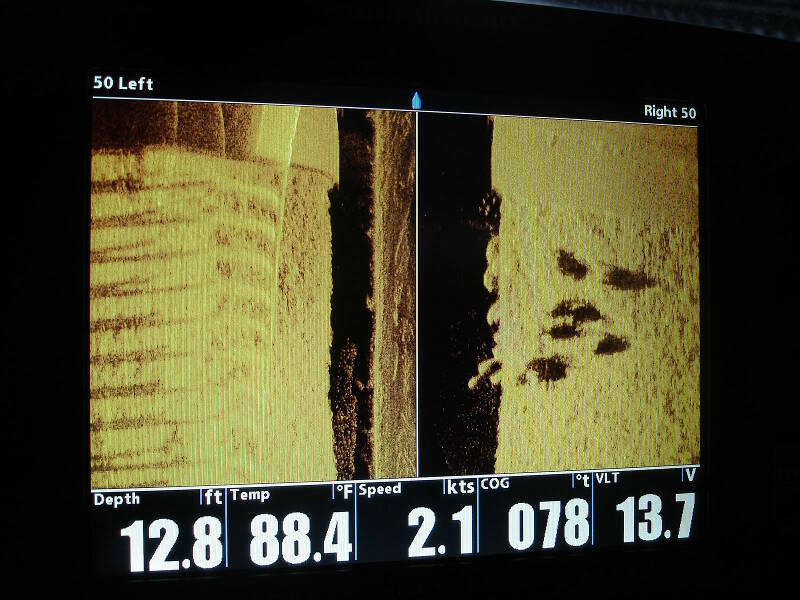
Roper has a built-in side scan sonar system, which is not the quality of our survey system, but very useful when navigating the boat. In the lock, the sonar can make out the shapes of a number of manatee swimming around the boat. Side scan sonar uses sound waves to make an acoustic image of the water and seafloor around the boat. Image courtesy of Image courtesy of the Search for the Lost French Fleet of 1565 Expedition, NOAA-OER/St. Augustine Lighthouse & Museum. Download larger version (jpg, 424 KB).
The delays have cost us time. It is not until 5:37 pm that we depart the marina, blasting our horn as we head to the Atlantic. But we have a long drive to go, through the Canaveral Lock, and we must also re-fuel before venturing out to sea.
While we are making our way into the lock, we can’t help but notice dark clouds on the horizon. Storms might also delay our departure, so we keep an eye out.
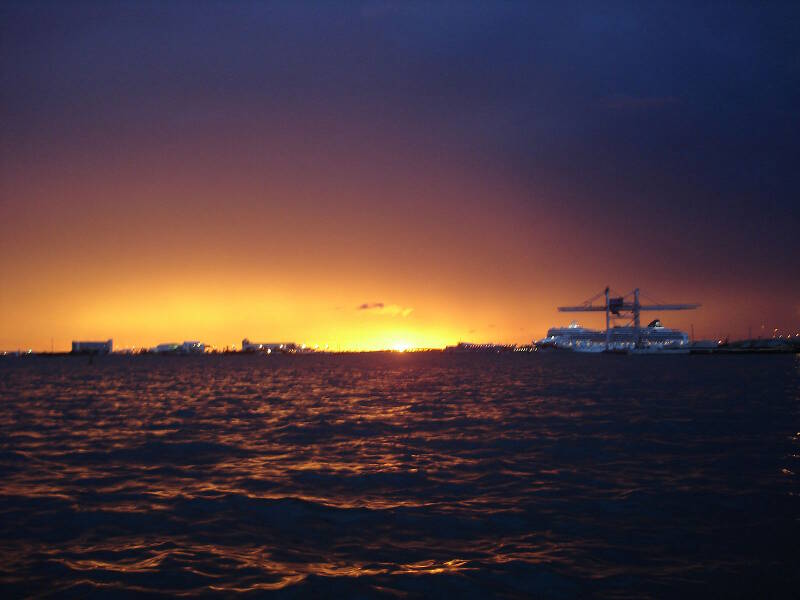
While waiting for the storm clouds on the radar to clear, we enjoy the sunset over Port Canaveral. Image courtesy of Image courtesy of the Search for the Lost French Fleet of 1565 Expedition, NOAA-OER/St. Augustine Lighthouse & Museum. Download larger version (jpg, 206 KB).
As we navigate the lock, we have to move slowly to avoid hitting a number of large manatee in the water with us. We notice that we can clearly make out these gentle marine mammals with the vessel’s built-in side scan sonar system.
Once through the lock, we make our way to Port Canaveral, a major port flanked by industrial facilities and gigantic cruise ships that dwarf our little research vessel. At Sunrise Marina, the only fuel dock open at the time of our arrival, we take on around 75 gallons of diesel fuel, to top off Roper’s tank, and also 10 gallons of gas (we have metal gas cans on board to fuel our portable generator, which we might need to power equipment if the main generator fails).
Upon our initial arrival, the storm hits, and we wait out the rain before taking on fuel. The rain is furious but fast, and it is not too long before we are fueled up, but looking at the radar we decide to wait at the dock a bit longer, to allow more of the storm to pass. We appear to be in the eye of the storm, with an enormous, ugly, multicolored blob all around us. But the sunset is beautiful!
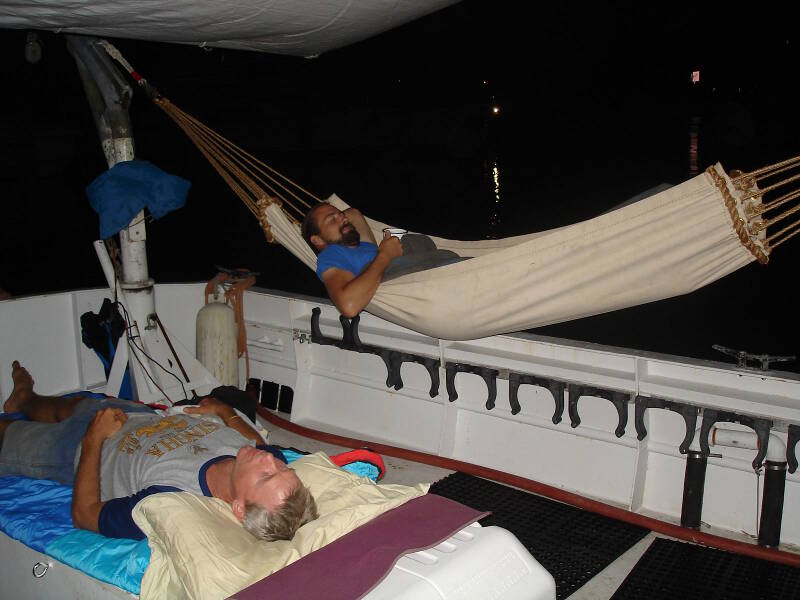
Sam and Brian sleep out on deck tonight, with the canopy overhead protecting them from the occasional light rains coming through. Brian has made his hammock by hand, which is a faithful reproduction based on 18th-century British naval hammocks. The design is well-suited for shipboard life and is quite comfortable. Image courtesy of Image courtesy of the Search for the Lost French Fleet of 1565 Expedition, NOAA-OER/St. Augustine Lighthouse & Museum. Download larger version (jpg, 255 KB).
By 9:00 pm we pull in our lines and head out to sea! While we had planned for this to be a transit day, we have had so many delays that it feels like a victory to head out through the inlet and into the open ocean. The victory is short-lived, however.
As we get out to sea, the boat takes a pounding from heavier than expected seas. Since we are relatively unfamiliar with this inlet, which is notorious for dynamically shifting shoals, Captain Burke makes the decision that we should turn around and head back in for the night. The fact that the voyage from Cape Canaveral to our survey area will take some seven hours also plays into this decision, since our crew is pretty exhausted. So, we reluctantly turn around and arrive at Cape Marina around 11:00 pm to get a much-needed good night’s sleep.
When we call the Cape Marina dockmaster the next day, ready to pay for our stay with a credit card, they offer us the dockage for free, so we are thankful for their support of our research. But in the meanwhile we have to put off our expedition for one more day. C'est la vie!